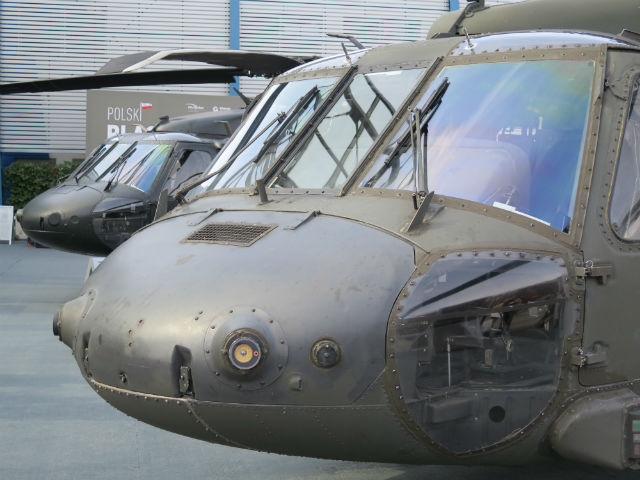All three contenders for Poland’s ongoing multirole helicopter procurement used this week’s MSPO defence show to mount a final push for the 70-unit deal, ahead of an end-September deadline for final submissions.
Warsaw is expected to select a preferred bidder by year-end ahead of a series of flight tests for the tri-service requirement, as it looks to retire its ageing fleet of mainly Russian types.
Although the simmering conflict in nearby Ukraine is causing alarm in Poland, defence minister Tomasz Siemoniak told reporters that the award of the contract was not being accelerated.
He describes 2014 as a “decisive year for the modernisation” of the country’s armed forces. “Everything is on track and is according to schedule. Owing to the [Ukraine] crisis we are strongly motivated to observe our deadlines,” he says.
The shortlist for the contest comprises the AgustaWestland AW149, Airbus Helicopters EC725 Caracal and Sikorsky S-70i Black Hawk, all three of which were on display outside MSPO’s exhibition hall in Kielce.
Although the bidders were largely unwilling to discuss the precise detail of Poland’s request for proposals, a large degree of local production and technology transfer is required.

Dominic Perry/Flightglobal
This could give AgustaWestland and Sikorsky an edge, due to their respective Polish subsidiaries PZL Swidnik and PZL Mielec. However, Airbus Helicopters is also promising substantial investment in the country, and suggests that it could become the “fifth pillar” of the Airbus Group, alongside France, Germany, Spain and the UK.
Although some of that investment will happen anyway, says Airbus Helicopters chief executive Guillaume Faury, winning the multirole contest – and a looming procurement of attack helicopters – would allow the manufacturer to accelerate its plans for the country.
“The level of investment I have in mind cannot be made in two to three years if we don’t have one or two big programmes to invest in,” he says. He estimates growth in the country would be around five times slower without the “catalyst” of the contract wins.
Faury is confident that the EC725 is the only one of the three helicopters on offer than can meet Poland’s wide-ranging requirements.
“We believe we are the only OEM to be able to offer a unique common platform for the different mission requirements that have been requested. The Caracal is today already available with the vast majority of systems, equipment and mission capabilities requested by Poland,” he says.
The company is already working through a similar tri-service contract for the EC725 in Brazil, he points out.

Dominic Perry/Flightglobal
Inevitably, AgustaWestland and PZL Swidnik see things a little differently. If Poland selects the AW149 it would be the first customer for the 8t rotorcraft, which only received military certification in July this year.
Danielle Romiti, AgustaWestland chief executive, says since its acquisition of PZL Swidnik in 2010, investments have transformed the company into the Anglo-Italian airframer’s “Polish industrial pillar”.
And Mieczyslaw Majewski, president of PZL Swidnik, is scathing of Airbus Helicopters’ proposals, noting that he is “not against the [PZL] Mielec people”.
He says: “Airbus Helicopters can say they will put jobs here, but how many? It will be 100 or 200 versus the 3,500 we employ. What does the government say to those people if they choose another company?”
Although PZL Swidnik has a long history of supplying helicopters for the Polish armed forces – most recently its W-3 Sokol and SW-4 Puszczyk – the very newness of the AW149 may count against it. Indeed, the company has sought, and been granted, an extension to develop the anti-submarine warfare (ASW) variant of the rotorcraft offered to the Polish navy, says project manager Zenon Witkowski.
“We succeeded in convincing the customer that the process of installing dedicated [mission] equipment on such a helicopter requires more time,” he says.

Dominic Perry/Flightglobal
Sikorsky, meanwhile, feels its offer of the S-70i – the international variant of the Black Hawk – is the most compelling. The helicopter is already assembled for the global market at PZL Mielec, with deliveries now “into the dozens”, says Bob Kokorda, vice-president defense systems and services at Sikorsky.
The S-70i is direct equivalent to the US-built UH-60M, says Kokorda, which he describes as “great proven product in demand by a lot of different countries”.
Although Polish analysts believe the Black Hawk may have the edge over its rivals thanks to support from the nation’s military, Sikorsky’s offer is not a simple one.
Poland’s requirement calls for one platform to be operated by all three services, and for those helicopters to be assembled locally.
However, to satisfy the ASW role, the US airframer can only pitch the S-70B, “a legacy version of the [SH-60] Seahawk” which will also not be built in Poland “because the quantities won’t be high enough”, says Kokorda. But he notes that “in the guts” of the two aircraft there is considerable commonality, which would reduce the “logistics and long-term life cycle costs”.
Source: FlightGlobal.com



















